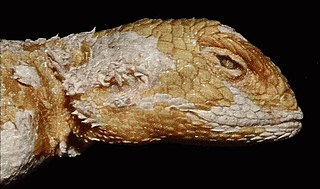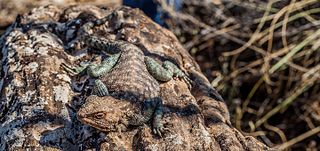
Agama is a genus of small-to-moderate-sized, long-tailed, insectivorous Old World lizards. The genus Agama includes at least 37 species in Africa, especially sub-Saharan Africa, where most regions are home to at least one species. Eurasian agamids are largely assigned to genus Laudakia. The various species differ in size, ranging from about 12 to 30 centimetres in length, when fully grown.

The long-legged buzzard is a bird of prey found widely in several parts of Eurasia and in North Africa. This species ranges from Southeastern Europe down to East Africa to the northern part of the Indian subcontinent. The long-legged buzzard is a member of the genus Buteo, being one of the larger species therein. This species is simultaneously considered relatively powerful and aggressive for its taxonomic group as well as a relatively sluggish raptor overall. Like most buzzards, it prefers small mammals such as rodents, including gerbils, ground squirrels, voles and rats, also taking reptiles, birds and insects as well as carrion. Adaptable to a variety of habitats, long-legged buzzards may nest on a variety of surfaces, including rocks, cliffs and trees. it is a typical buzzard in its reproductive biology. The long-legged buzzard is widely distributed and appears to be quite stable in population. Therefore, it is considered as Least Concern by the IUCN.

The ring-necked dove, also known as the Cape turtle dove or half-collared dove, is a widespread and often abundant dove species in East and southern Africa. It is a mostly sedentary bird, found in a variety of open habitats. Within range, its penetrating and rhythmic, three-syllabled crooning is a familiar sound at any time of the year. Its name is derived from the semi-collar of black feathers on the lower nape, a feature shared with a number of Streptopelia species. Like all doves, they depend on surface water. They congregate in large flocks at waterholes in dry regions to drink and bathe.

The orange-winged pytilia, also known as the golden-backed pytilia, is a species of estrildid finch found in Africa. It has a wide range and the International Union for Conservation of Nature has assessed it as being of least concern.

The augur buzzard is a fairly large African bird of prey. This species is distinct in typical adult plumage for its blackish back, whitish underside and orange-red tail, while juvenile augur buzzards are generally rather brown in colour; however a dark morph is known, which causes the bird's entire body to become darker. This member of the Buteo genus is distributed in several parts of the central and southern Africa, normally being found from Ethiopia to southern Angola and central Namibia. It is resident and non-migratory throughout its range. This is a species of mountains, and adjacent savannah and grassland. This is a typical buteonine raptor, being a generalist predator which tends to prefer small mammals supplemented by reptiles and birds among various prey items.

The buffy pipit is a species of bird in the Motacillidae family. It is found in plains and open countryside in southern and eastern Africa. The IUCN has assessed its conservation status as being of least concern.

The grey-headed bushshrike, colloquially known as the ghostbird, is a species of passerine bird in the family Malaconotidae. It is widespread throughout sub-Saharan Africa, although relatively absent in Central Africa and the interior of southern Africa. It is the most widespread species of its genus, which consists of large bushshrikes with massive bills and mournful hooting calls. It occurs sparsely in a range of wooded habitats, though typically in denser vegetation within dry or moist savannah. The monogamous pairs occupy woodland with sufficient cover. They are sedentary, but will undertake limited post-breeding movements.

The African pitta is an Afrotropical bird of the family Pittidae. It is a locally common to uncommon species, resident and migratory in the west, and an intra-African migrant between equatorial and southeastern Africa. They are elusive and hard to observe despite their brightly coloured plumage, and their loud, explosive calls are infrequently heard. The plump, somewhat thrush-like birds forage on leaf litter under the canopy of riparian or coastal forest and thickets, or in climax miombo forest. They spend much time during mornings and at dusk scratching in leaf litter or around termitaria, or may stand motionless for long periods. Following rains breeding birds call and display from the mid-canopy.

The common agama, red-headed rock agama or rainbow agama is a species of lizard from the family Agamidae found in most of sub-Saharan Africa. To clear up centuries of historical confusion based on Linnaeus and other authors, Wagner et al. designated a neotype for the species, using a previously described specimen from Cameroon in the collection of the Zoologisches Forschungsmuseum Alexander Koenig in Bonn. The species name was formerly applied to a paraphyletic collection of taxa ; subsequent mitochondrial DNA analysis of various populations indicates they represent separate species. Consequently, three former subspecies A. a. africana, A. a. boensis, and A. a. mucosoensis are now considered separate species, and A. a. savattieri is considered synonymous with A. africana.

The bark mantises and ground mantises are praying mantises now placed in the family Eremiaphilidae that are native to the Afrotropics. They are generally light brown but more silvery on the wings. The wings are attractively reticulated, and the veins may be mottled dark and pale. The head is wider than the pronotum, which is rounded anteriorly, and doesn't overlap with the rear of the head. The pronotum is depressed, with its sides more or less parallel, and only a weak supra-coxal bulge is present. The anterior tibia are flattened and greatly expanded longitudinally, and the tibial claw does not fit into a pit between the 1st and 2nd external spines of the anterior femora, as in a few mantis groups.

The Mwanza flat-headed rock agama or the Spider-Man agama, because of its coloration, is a lizard reptile in the family Agamidae, found in Tanzania, Rwanda, and Kenya.

Agama aculeata, the ground agama, is a species of lizard from the family Agamidae, found in most of sub-Saharan Africa.
The Elmenteita agama or Elmenteita rock agama is a species of lizard from the family Agamidae. The species is endemic to Kenya with the type locality being Lake Elmenteita, hence the common name.

Agama rueppelli, commonly known as the arboreal agama or Rüppell's agama, is a species of lizard in the family Agamidae. The species is endemic to East Africa.

The southern rock agama or southern African rock agama is a species of lizard from the family Agamidae that occurs in Southern Africa in Zambia, South Africa, Eswatini, Mozambique, Zimbabwe and Botswana. It lives in small colonies on rocky outcrops, and the males are very conspicuous for their bright blue heads.

Acanthocercus atricollis, the black-necked agama or southern tree agama, is a species of tree agama that is native to East, Central and southern Africa. Its largest continuous range is in southeastern Africa, and it occurs at high densities in the Kruger National Park.

Agama bibronii, Bibron's agama or the North African rock agama, is a species of lizard belonging to the family Agamidae from north western Africa.

Agama anchietae, also known commonly as Anchieta's agama and the western rock agama, is a species of lizard in the family Agamidae. The species is native to southern Africa.

Agama kirkii, also known commonly as Kirk's rock agama, is a small species of lizard in the family Agamidae. The species is native to southeastern Africa. There are two recognized subspecies.




















